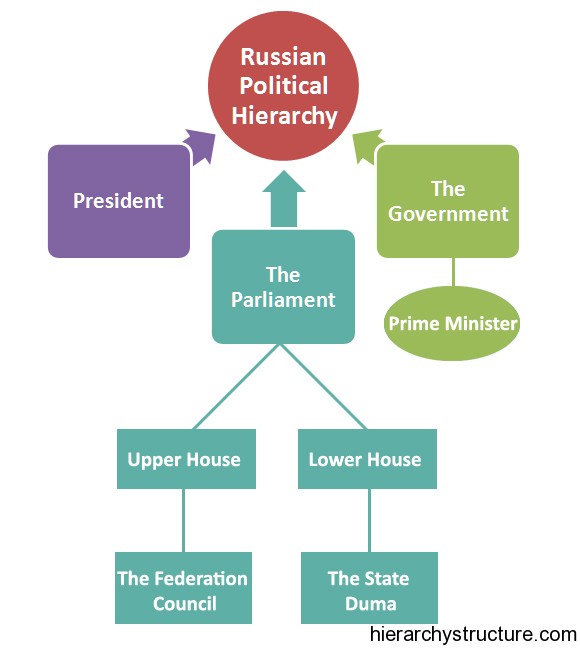Russia is a federal presidential republic and the executive power is divided between the President and the Prime Minister. Among the two, the President is the dominating figure. In the Russian political hierarchy, the legislature is represented by the Federal Assembly of Russia and the judicial power is administered by the Ministry of Justice.

President:
- The President is the head of the state and is elected by popular vote every six years. S/he can be elected for a maximum of two consecutive terms.
- In the past, the constitution had four years of presidential terms but it is extended to six years by the parliament in the year 2008.
- The six year term rule will be implemented from this year onwards.
- The president determines the basic domestic and foreign policies.
- The president acts as the commander-in-chief of the armed forces.
- The President resolves issues of citizenship of the Russian federation.
The Government:
- The Prime Minister is the head of the government, which is appointed by the president and confirmed by the State Duma, which is the lower house of the federal assembly of Russia.
- The government is housed in the White House of Moscow.
- The government oversees the implementation of the domestic and foreign policies.
- The government oversees the execution of the financial and monetary policies.
- The government also works out the federal budget and ensures the successful implementation of human rights and freedoms.
The Parliament:
- This is the federal assembly of political hierarchy.
- It makes federal laws and approves treaties.
- It declares war and has the power of the purse.
- The parliament has two chambers, one is the lower house and another is the upper house. The lower house is called as the State Duma and the upper house is called as the Federation Council.
The Federation Council:
- The Federation Council was created by the 1993 constitution to act as the voice of Russia’s federated entities.
- The Council has a total of 168 members, who are known as the senators.
- Each of the 84 federal subjects of Russia sends two members to the council. The Council is not directly elected. It consists of representatives of Russia’s federal entities. One member is elected by the entity’s legislature and the other member is elected by the entity’s head.
- The terms of the members of the federation council are not fixed. Instead, they depend on the terms of the regional bodies that chose the members.
The State Duma:
- This is the lower house of the parliament in the Russian political hierarchy. This is a more powerful house and all the bills that are passed by the Federal Council must first be considered by the State Duma.
- The State Duma has total 450 members, known as deputies. The 4502 deputies are elected for duration of five year.
- The State Duma is headquartered in central Moscow.
- Once a bill is passed by State Duma, a draft law is sent to the Federation Council. If the Federation Council rejects the draft law, both the lower and upper chambers form a commission to opt for a compromise.
To know more about China Political Hierarchy Click Here
